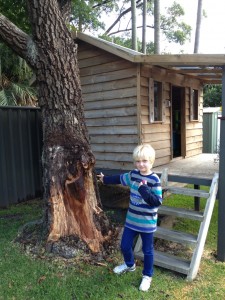Summer Branch Drop (SBD) is a phenomenon that occurs to trees all over the world as well as to trees here on the Central Coast.
It can happen to healthy trees that have no visible defects.
‘Summer branch drop’ occurs in afternoons of late summer, or early autumn, during calm conditions with warm to hot temperatures.
It is frustrating for Arborists due to our lack of ability to predict and prevent a summer branch drop event.
Summer branch drop affects many different species of hardwoods and softwoods.
Branches break at some distance from their union to the stem.
SBD is sometimes referred to as sudden limb failure, sudden limb drop, and summer limb drop.
SBD has, on occasions, resulted in fatalities.
Why Does it occur?
Some research suggests that SBD is related to inter-cellular water content (Harris, Shigo, Strouts & Winter, Lonsdale).
Shigo (1989) suggests that branches with cracks (from internal wounds) may spread outward. So long as the wet wood along the secondary crack keeps the wood moist then the branch will continue to bend adequately. When the crack begins to dry the branch may fracture. It should be noted that Shigo makes no connection to the term SBD. However, Harris (2004) makes reference to this as one possible reason for SBD.
Other factors include:
1. A reduction in wood strength by bacterial wet wood.
2. An increase in branch water content (and weight) resulting in a reduction in transpiration during humid, calm weather.
3. A weakening of wood-cell cementation due to increased ethylene production in conditions of high humidity, high temps, and low transpiration.
4. An increase in weight due to leaf & fruit production.
Other sources cite pressure as a contributing factor; gas pressure from the bacterial wet wood, and water pressure from a lack of transpiration during high humidity.
We recommend hazard minimization options for mature species which are susceptible to the phenomenon of Summer Branch Drop:
Remove or reduce long horizontal branches;
Prune trees to encourage tapered branches;
Maintain tree health and moderate vigour;
Inspect for and correct structural defects, removing low vigour limbs and those with decay or cavities;
Restrict activity under over mature trees of low vigour.
Contact your local Central Coast Arborist to have your trees inspected. T&G services provide a free tree health and hazard assessment, just CLICK here to request an inspection.




